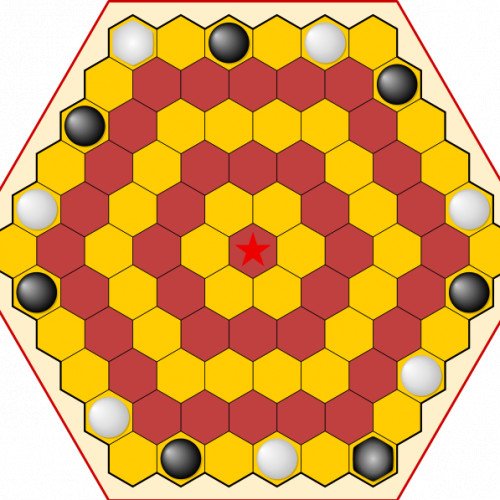AGON VS HOUNDS AND JACKALS

AGON
Agon (or Queen's Guards or Royal Guards) is an strategy game invented by Anthony Peacock of London, and first published in 1842. It is a two player game played on a 6×6×6 hexagonal gameboard, and is notable for being the oldest known board game played on a board of hexagonal cells. Each player has one queen and six guards. Players determine who moves first, then turns alternate. On each turn, a player moves one of his pieces. The object of the game is to be first to maneuver one's queen to the central hex (the throne) at the center of the board, and surround her with all six of her guards. The gameboard may be thought of as a series of concentric rings of hex cells (highlighted by rings of alternating colors). Pieces move one step at a time to an adjacent cell, either sideways in the same ring, or towards the throne to the next ring. The cell moved to must be vacant. Only the queen may move to the throne.
Statistics for this Xoptio

HOUNDS AND JACKALS
Hounds and jackals is the modern name given to an ancient Egyptian game that is known from several examples of gaming boards and gaming pieces found in excavations. The modern name was invented by Howard Carter, who found one complete gaming set in a Theban tomb of ancient Egyptian pharaoh Amenemhat IV that dates to the 12th Dynasty. The latter game set is one of the best preserved examples and is today in the Metropolitan Museum of Art in New York. He called it Hounds contra Jackals. Another, less often used modern name is fifty-eight holes. The gaming board has two sets of 29 holes. Gaming pieces are ten small sticks with either jackal or dog heads. The game appeared in Egypt, around 2000 BC and was mainly popular in the Middle Kingdom. In the 1956 movie The Ten Commandments, Pharaoh Seti (Cedric Hardwicke) and Nefretiri (Anne Baxter) are shown playing the game. Hounds and Jackals, also known as 58 Holes, is a well-known Bronze Age board game which was invented in Ancient Egypt 4,000 years ago. Hounds and Jackals appeared in Egypt, around 2000 BC and was mainly popular in the Middle Kingdom. William Mathew Flinders Petrie initially discovered the game and published about it in 1890. More than 40 examples of the game have been revealed in Egypt, Mesopotamia, Israel, Syria, Iran, Azerbaijan, around the Levant and Mediterranean since that time. Sticks were made of expensive materials such as ivory, silver and gold based on the findings at some of the archaeological sites. Wood was also used in the preparation of ordinary pegs, but such examples would not have survived. The complete set of this Egyptian game discovered in 1910 by the British archaeologist Howard Carter is now displayed in the Metropolitan Museum of Art in New York.